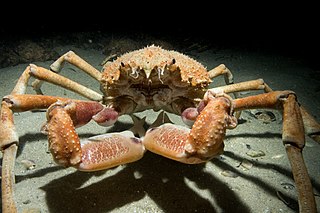
Jean Victor Audouin, sometimes Victor Audouin, was a French naturalist, an entomologist, herpetologist, ornithologist, and malacologist.

Henri Milne-Edwards was a French zoologist.

Alphonse Milne-Edwards was a French mammalogist, ornithologist, and carcinologist. He was English in origin, the son of Henri Milne-Edwards and grandson of Bryan Edwards, a Jamaican planter who settled at Bruges.

Caridina is a genus of freshwater atyid shrimp. They are widely found in tropical or subtropical water in Asia, Oceania and Africa. They are filter-feeders and omnivorous scavengers. They range from 0.9 to 9.8 mm to 1.2–7.4 mm in carapace length.

Léon Louis Vaillant was a French zoologist. He is most famous for his work in the areas of herpetology, malacology, and ichthyology.

Leptograpsus variegatus, known as the purple rock crab, is a marine large-eyed crab of the family Grapsidae, found in southern subtropical Indo-Pacific Oceans. It grows to around 50 millimetres (2.0 in) shell width. It is the only species in the genus Leptograpsus.

Parthenopidae is a family of crabs, placed in its own superfamily, Parthenopoidea. It comprises nearly 40 genera, divided into two subfamilies, with three genera incertae sedis:

Filhollianassa filholi is a ghost shrimp of the family Callianassidae, endemic to New Zealand, which grows up to 60 mm (2.4 in) long. It was known as Biffarius filholi until a 2019 taxonomic revision of the group.

Palaemon affinis is a species of shrimp of the family Palaemonidae. Early authors used the name Palaemon affinis for specimens now known to belong to a variety of species, but P. affinis is now known to be endemic to the waters of New Zealand.
Epicaridea is a former suborder of isopods, now treated as an infraorder in suborder Cymothoida. They are ectoparasites that inhabit other crustaceans, namely ostracods, copepods, barnacles and malacostracans. Epicarideans are found globally. Epicaridea are generally less well researched than other isopods.

Cymothoida is the name of a suborder of isopod crustaceans with a mostly carnivorous or parasitic lifestyle. It contains more than 2,700 described species in four superfamilies. Members of the suborder are characterised by their specialised mouthparts which include a mandible with a tooth-like process which is adapted for cutting or slicing.

Turbo regenfusii, common name the great green turban, is a species of sea snail, a marine gastropod mollusk in the family Turbinidae, the turban snails.

Stramonita delessertiana is a species of sea snail, a marine gastropod mollusk in the family Muricidae, the murex snails or rock snails.
Thylacodes masier is a species of sea snail, a marine gastropod mollusk in the family Vermetidae, the worm snails or worm shells.

Johngarthia lagostoma is a species of terrestrial crab that lives on Ascension Island and three other islands in the South Atlantic. It grows to a carapace width of 110 mm (4.3 in) on Ascension Island, where it is the largest native land animal. It exists in two distinct colour morphs, one yellow and one purple, with few intermediates. The yellow morph dominates on Ascension Island, while the purple morph is more frequent on Rocas Atoll. The species differs from other Johngarthia species by the form of the third maxilliped.

Pisinae is a subfamily of crabs in the family Epialtidae, comprising the following genera:

Tylothais savignyi is a species of sea snail, a marine gastropod mollusk, in the family Muricidae, the murex snails or rock snails.

Heterocyathus is a genus of coral of the family Caryophylliidae.

Le Talisman was a French Navy sloop built at Le Havre in 1862 which was used for geological, biological and hydrological exploration in the Atlantic Ocean and Mediterranean Sea at the end of the 19th century. It first served as a communications vessel ("aviso"), and was both sail and propeller driven.

Leptomithrax gaimardii is a species of crab in the Majidae family, first described by Henri Milne-Edwards in 1834 as Paramithrax gaimardii, from a specimen found in New Zealand waters by Joseph Paul Gaimard who is honoured by the species epithet.

















